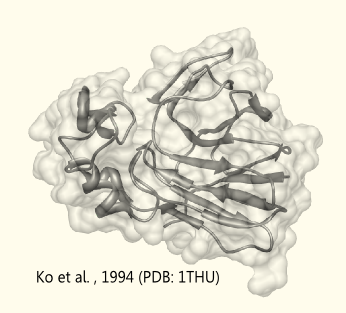Part:BBa_K801080
Prepro-Thaumatin, yeast codon optimized
The BioBricks contains the coding region for Prepro-Thaumatin that is believed to be exported on it's own http://www.ncbi.nlm.nih.gov/pubmed/6327079 Edens et al., 1984. The original gene sequence was optimized for best yeast codon usage using GeneArt® GeneOptimizer®.
Background and principles
Thaumatin is a natural ╬▒+╬▓-protein which is synthesized by the katamfe plant (Thaumatococcus daniellii) ÔÇô a species of tropical flowering plants - and belongs to the thaumatin-like protein family. There exist different varieties of thaumatin, however, thaumatin I und thaumatin II are well characterized and differ only in one position (position 46 ÔÇô without signaling sequence; thaumatin I Asn; thaumatin II Lys). Both are said to be 2000 to 100000 times sweeter than sucrose on molar basis, but the sweetness builds slow and lasts long.
Thaumatin is a single chain with 207 amino acids residues and eight disulfide bonds and a molecular weight of 22.2 kDa. It is highly water soluble, stable at heating (not for cooking, bakery, etc.) and stable under acidic conditions. The production of thaumatin is induced by an attack upon the plant by viroid pathogens. Thus it is involved in systematically acquired resistance and stress response.
Thaumatin has been approved as a sweetener in the European Union (E957).
The general idea is to create via genetic engineering of Saccharomyces cerevisiae a system that expresses thaumatin, respectively the direct precursor (preprothaumatin). The N-terminal "pre" part is the internal signalling sequence for secretion, the C-terminal "pro" sequence supports the correct and functional folding of thaumatin. Alternatively one could have used a fusion product of prothaumatin and the Mat-α-factor to achieve secretion.
Preferable seems to be the natural preprothaumatin, because of the expected higher yield http://www.ncbi.nlm.nih.gov/pubmed?term=21636903 Masuda et al., 2011 and the possibility that the pre-sequence is necessary for the correct procession http://www.ncbi.nlm.nih.gov/pubmed?term=17897626 Ide et al., 2007. A similar construct was used by the Kyoto University (Ide et al., submitted) in Pichia pastoris with a the pPIC6╬▒ expression vector with a high yield (especially with the preprothaumatin I gene and without the ╬▒-factor secretion signal).
The molecular and physiological effects of thaumatin
The sweet taste receptor is a heterodimeric receptor composed of T1R2 (also TAS1R2) and T1R3 (also TAS1R3) subunits. The large amino-terminal domains (NTD) of the T1R2 and T1R3 subunits have shown to be responsible for the primary ligand binding http://www.ncbi.nlm.nih.gov/pubmed?term=22450161 Maîtrepierre et al., 2012. In addition these receptors have a transmembrane heptahelical domain. T1R receptors belong to the family of class C G-Protein coupled receptors (GPCRs), which in this case means that through ligand binding an elevation of the cAMP concentration in the taste buds is induced [[http://www.ncbi.nlm.nih.gov/pubmed?term=19489607 Ide et al., 2009], [http://www.ncbi.nlm.nih.gov/pubmed?term=15087236 Ozeck et al., 2004]]. As a result a decrease in the intracellular cAMP accumulation is measured. Released calcium (Ca2+) seems to be another independent second messenger within the transduction of the taste response (downstream of taste receptors) http://www.ncbi.nlm.nih.gov/pubmed?term=16510847 Trubey et al., 2006.
However, not only sucralose or other sugars can bind with the NTDs of the sweet taste receptor, but also thaumatin http://www.ncbi.nlm.nih.gov/pubmed?term=19489607 Ide et al., 2009. It seems to have a longer lasting and stronger effect than sucralose.
Characterization
Expression of Thaumatin
Characterization of this BioBrick was carried out using the yeast expression vector BBa_K801004 for transient transfection with the yeast strain INVSc1.
Ion exchange chromatography
Preprothaumatin becomes posttranslationally modified by cleaving a part of the N- and the C-terminal polypeptide. Therefore it was not possible to add a tag for affinity chromatography. For this reason it was necessary to purify the protein from the cytoplasm of the disintegrated yeast cells using ion exchange chromatography to have a proof of principle.
Experimental details:
- Samples: cell lysate, supernatant from culture, reference for thaumatin (MedHerbs)
- Dialysis against 20mM MES Buffer pH 6.0 (twice) using a 12-16 kDa dialysis membrane
- Chromatography with a Äkta purifier equipped with a Ressource S 6ml (S: Methyl sulfonate (strong cation exchanger))
- Sample was applied using a super-loop
- Wash with two column volumes 20mM MES Buffer pH 6.0
- Elution with a gradient of 0 - 500 mM NaCl over 5 column volumes
- Fractions of 1 ml were collected during the elution
Experimental results:
- Reference Thaumatin (see figure A and B)
- nearly no protein in the flow through during sample application (see figure A)
- a major peak eluting at ~14 mS*cm-1 which corresponds to fraction Nr. 14 see figure A)
- The corresponding SDS-PAGE showed a clear band around fraction Nr. 14 corresponding matching the expected 22 kDa
- Cell lysate
- high concentration of protein in the flow through (see figure C and D)
- no clear peak around fraction 14 could be detected
- The SDS-PAGE performed from the reference and the fractions 12 to 15 showed a weak band at the height of the reference. This band having the same size as the reference (see running properties on SDS-PAGE in figure D) and the same isoelectric point (both eluted in fraction 14) is very likely to be thaumatin which was produced by the yeast cells.
- Supernatant of yeast culture (see figure E and F)
- Export of the protein in high concentrations was unlikely to happen, therefore 48 ml of supernatant were loaded on the column
- Ratio between flowthrough and eluted protein was less favorable compared to the cell lysate.
- Total protein quantities were to low to be detected by Comassie stain, therefore a silver stain was performed (see figure F)
- Beside the reference no additional proteinbands could be detected on the silver stained SDS-PAGE
Conclusion from this experiment:
A proof of principle for the expression of thaumatin was achieved using ion exchange chromotography and comparison of bands obtained on an SDS-PAGE relative to a standard of thaumatin.
Sequence and Features
- 10COMPATIBLE WITH RFC[10]
- 12COMPATIBLE WITH RFC[12]
- 21COMPATIBLE WITH RFC[21]
- 23COMPATIBLE WITH RFC[23]
- 25COMPATIBLE WITH RFC[25]
- 1000COMPATIBLE WITH RFC[1000]
//cds/biosynthesis
//chassis/eukaryote/yeast
| None |



